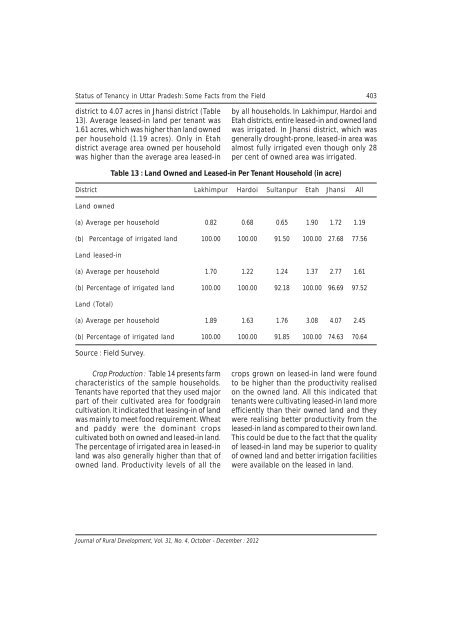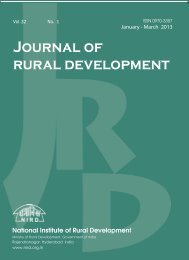October - December 2012 - National Institute of Rural Development
October - December 2012 - National Institute of Rural Development
October - December 2012 - National Institute of Rural Development
- No tags were found...
Create successful ePaper yourself
Turn your PDF publications into a flip-book with our unique Google optimized e-Paper software.
Status <strong>of</strong> Tenancy in Uttar Pradesh: Some Facts from the Field 403district to 4.07 acres in Jhansi district (Table13). Average leased-in land per tenant was1.61 acres, which was higher than land ownedper household (1.19 acres). Only in Etahdistrict average area owned per householdwas higher than the average area leased-inby all households. In Lakhimpur, Hardoi andEtah districts, entire leased-in and owned landwas irrigated. In Jhansi district, which wasgenerally drought-prone, leased-in area wasalmost fully irrigated even though only 28per cent <strong>of</strong> owned area was irrigated.Table 13 : Land Owned and Leased-in Per Tenant Household (in acre)District Lakhimpur Hardoi Sultanpur Etah Jhansi AllLand owned(a) Average per household 0.82 0.68 0.65 1.90 1.72 1.19(b) Percentage <strong>of</strong> irrigated land 100.00 100.00 91.50 100.00 27.68 77.56Land leased-in(a) Average per household 1.70 1.22 1.24 1.37 2.77 1.61(b) Percentage <strong>of</strong> irrigated land 100.00 100.00 92.18 100.00 96.69 97.52Land (Total)(a) Average per household 1.89 1.63 1.76 3.08 4.07 2.45(b) Percentage <strong>of</strong> irrigated land 100.00 100.00 91.85 100.00 74.63 70.64Source : Field Survey.Crop Production : Table 14 presents farmcharacteristics <strong>of</strong> the sample households.Tenants have reported that they used majorpart <strong>of</strong> their cultivated area for foodgraincultivation. It indicated that leasing-in <strong>of</strong> landwas mainly to meet food requirement. Wheatand paddy were the dominant cropscultivated both on owned and leased-in land.The percentage <strong>of</strong> irrigated area in leased-inland was also generally higher than that <strong>of</strong>owned land. Productivity levels <strong>of</strong> all thecrops grown on leased-in land were foundto be higher than the productivity realisedon the owned land. All this indicated thattenants were cultivating leased-in land moreefficiently than their owned land and theywere realising better productivity from theleased-in land as compared to their own land.This could be due to the fact that the quality<strong>of</strong> leased-in land may be superior to quality<strong>of</strong> owned land and better irrigation facilitieswere available on the leased in land.Journal <strong>of</strong> <strong>Rural</strong> <strong>Development</strong>, Vol. 31, No. 4, <strong>October</strong> - <strong>December</strong> : <strong>2012</strong>

















